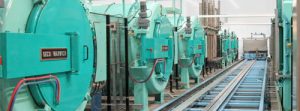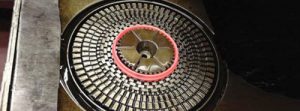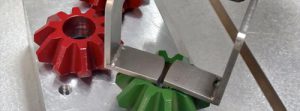Learning from failure in bending stress
A couple of years ago, as I was finishing my graduate studies, I was lucky enough to participate in the Strong Bar competition put on...
Distortion during heating
Minimizing distortion involves more than just optimizing cooling
Hardness scale conversion
The use of hardness testing as a quality control method to check the outcome of a thermal treatment process is a common application of...
Carburizing
While some heat treatments are used to soften the material or improve its machinability, most are processed to obtain strengthened or hardened properties. The...
Residual stress evaluation in bearings
Lingering stress is not easily identified during production, but has a direct impact on wear performance and fatigue life
Case Depth Determination
Methodology to ensure design intent is satisfied
An overview of heat treatment techniques
Editor’s note » This is the second in a five-part series.
In this second segment of my series on heat-treating techniques, I will discuss the...
Stress evolution during quench hardening of steel
Quench hardening of steel components involves complex, nonintuitive phenomena, particularly as it relates to the dimensional changes and stresses induced. Figure 1 shows a...
Surface stress is key in rolling contact fatigue
Most bearing failures can be attributed to some form of rolling contact fatigue. Many factors influence rolling contact fatigue, but two main factors are...
Different Scales Are Used For Rockwell Hardness Testing
Production Bench Rockwell Hardness Testing of Small Work Pieces
As induction hardened workpieces get smaller in size, attention to the proper abrasive cutting of the...
Achieving results through cold treatment
Cold treatment is a sub-zero thermal treatment process primarily used to reduce the retained austenite content of alloy and high carbon steels. Cold treatment...
Microstructural evolution, its effect on Ti6Al4V alloy
Titanium alloys are extensively used in aerospace, petrochemical, marine, and medical applications, thanks to their superior strength-to-weight ratio at elevated temperature, corrosion resistance, and...
Creep deformation mechanisms in 9CrMo steel
The Generation-IV reactors in nuclear power plants are expected to address the growing energy demand by producing electricity and, at the same time, mitigating...
Process comparison to improve fatigue performance
Bending fatigue and contact fatigue performance can be improved by the presence of residual compressive surface stresses . Many processes can induce these compressive...
Microstructural effect of Alloy 718 on fatigue strength
Gas turbine engines are widely used in aviation, power generation, and oil and gas industries. They are used in land, air, and marine. The...
Accounting for carbon rejection can head off trouble
The heat treatment of steel alloys is required in almost every industry to acquire the necessary properties for a material given a particular application....
Carbon Diffusion and Carburizing Parameter Selection
Although carburizing is a complicated process, it can be broken down into two main steps: carbon generation in the furnace and carbon diffusion into...
Press quenching tooling design using simulation
Steel powertrain gears are commonly carburized and quench hardened to improve strength and wear characteristics. However, solid-state phase changes occurring within the steel during...
How to keep decarburization in check
The performance of heat-treated steel components is largely dependent on the condition of their surface. Wear and fatigue resistance are examples of design criteria...
Enhanced properties of metal matrix nanocomposites
Application of carbon nanotube (CNT) reinforced metal matrix nanocomposite (MMNC) has been increasing rapidly since the discovery of CNT in the 1990s. These novel...
Non-Martensitic Transformation Products (NMTP)
Whether formed during a conventional quench and tempering process, carburizing, or induction hardening, non-martensitic transformation products (NMTP) are widely considered undesirable microstructural features. However,...
Carbon potential verification
Choose from several verification methods for best fit, then develop a plan to correct for out-of-spec test results
Improving temperature uniformity during tempering
The final step in any steel heat-treatment quenching process which produces a martensitic microstructure is tempering. Martensite is a metastable phase and is extremely...
Gear inspection methods from heat-treat simulation
Gear design is a complex process, involving dozens of parameters, tolerances, and relationships to mating components. Generally, professional standards guide the gear designer to...
Heat transfer: Convection’s reach
Many years ago, as a mechanical engineering undergraduate student, an analogy was offered to help explain the interplay between convection and conduction in heat...
Metal plasticity in manufacturing
Understanding the plastic behavior of steel plays a crucial role in manufacturing. From raw billet to parts in service, some form of plastic deformation...
Hardening and tempering in the same cell
Tempering hardened steels is one of the most important heat treating processes used in part manufacturing. Induction tempering produces hardness and mechanical properties similar...
Variation in Hardenability
Many heat-treating processes cannot tolerate appreciable variations in steel hardenability. For an established in-control process, deviations in chemical composition and starting microstructure may result...
Compelling reasons normalizing produces high quality gears
In this day and age, adding steps to the gear manufacturing process is not highly desirable unless the benefits far outweigh the costs incurred....
Modeling can improve press quenching process
A combination of carburization and quench hardening is often used to increase the strength and improve fatigue performance of steel parts. During quenching, stresses...
Stress modeling of the WAAM process
A thermal model was previously developed and executed to simulate the Wire Arc Additive Manufacturing (WAAM) process, using the Goldak Flux Distribution to model...
Determining austenite grain size
Grain size is a critical metallurgical characteristic, significantly influencing design parameters such as strength and toughness. Austenite grain size (often referred to as prior-austenite...
Low pressure carburization simulation of steel alloys with strong carbide forming elements
Low pressure carburizing (LPC) is quickly gaining popularity across many industries due to LPC’s reduced cycle time, lack of oxidation/decarburization at and near surface,...
Evaluating effect of heat treat on flank slope profile deviation of steel gears using...
The finish machining of a gear is undoubtedly one of the most important manufacturing steps. It sets the geometry, surface condition, and residual stress...
Evaluating a material’s response during austenitization
Carbon content in steel has a direct correlation to the hardness and overall strength of a component after heat treatment. Carbon can take many...
Nonlinear distortion response during gas quenching
High-pressure gas quenching (HPGQ) is touted as a way to reduce distortion of difficult-to-quench geometries. Quench pressures and quench gas flow velocities are chosen...
Coupling Alloy and Process Selection
Combining both alloying and processing into a single strategy to achieve a desired level of performance sounds like a simple concept, but can be...
Kanthal APMT for nuclear-energy application
The major earthquake and tsunami that occurred in Japan in 2011 did serious damage to boiling water reactors of the Fukushima-Daiichi nuclear power plant....
Combatting undesirable NMTP formations
Whether formed during a conventional quench and tempering process, carburizing, or induction hardening, non-martensitic transformation products (NMTP) are widely considered undesirable microstructural features. However,...
Predicting strains key to evaluating heat-treat response
Quench hardening of steel components requires the components to be heated to a temperature such that the solid-state crystal structure of the material changes...




































